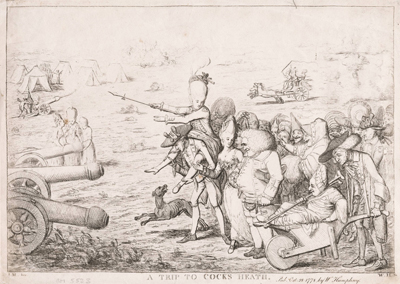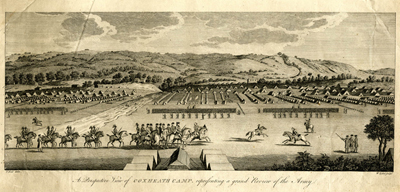A Trip to Cocks Heath
A Trip to Cocks Heath was prompted by the rage for all things military which swept across England with the American War for Independence and especially when the French Alliance with America in February of 1778 seemed to make a French landing in Britain a distinct possibility. Camps began to spring up around all the major British ports to protect British shipping and on the perimeters of London to defend the capital. Its size (15,000 men) and its proximity to London made Coxheath one of the best known military encampments at the time. Every day people flocked there to view the red coated solidiers with their horses, guns, and cannons and to watch them perform military drills.

A Trip to Cocks Heath [Oct. 28, 1778]
© Lewis Walpole Library, Yale University
But the immediate impulse for the print was likely the Entertainment in Two Acts composed by the author of the enormously successful School for Scandal, R.B. Sheridan, and performed nightly at his theater in Drury Lane. The Camp, as it was called, opened on October 15th, just two weeks before the print appeared, and ran for 57 performances. Set at the camp at Coxheath, the musical comedy included a "Perspective Representation of the Grand Camp at Coxheath, from a view taken by Mr. De Loutherbourg and executed under his direction." Although unrelated in tone and values, the nightly performances of The Camp would have kept Coxheath in the public eye and stimulated interest in the print.

A Perspective View of Coxheath Camp [circa 1778]
© Trustees of the British Museum
It's difficult to resist a good pun, and even more difficult when it is perfectly appropriate. So when a camp of 15,000 military men was established at Coxheath, it was more or less inevitable that a brisk traffic in sexual services would become one of its salient features and that it would soon be known as Cocks Heath.
Picking up on that all too obvious pun, the print features an assortment of randy women of all ages, eager to explore the camp and examine the most prominent of its artillery, the phallic cannons, where size truly makes a difference. In the distance behind, a woman in a two-wheeled curricle (usually favored by men about town) whips her horses onward as if she and her female companion can't get to he camp fast enough. A third woman hangs on behind. The foreground group is led by a woman wearing the feminine version of regimentals made popular by the Duchess of Devonshire and riding upon a disconsolate soldier while a male dog barks up her dress.Next to her a young and pretty wife has taken the arm of her older husband and is leading him on. And finally, a much older crone with crutches is being carried in a wheel barrow by her downtrodden husband(?). Everywhere you look, the camp seems to have unleashed the feminine libido and in every instance, women are dominating.
A Trip to Coxheath is usually assumed to to have been based on a drawing by John Hamilton Mortimer. The style bears some resemblance to Mortimer's and there is an "J.M. Inv." in the bottom left of the print. But I think there are multiple reasons for believing that this is not Mortimer but, in fact, the young and unknown Gillray mimicking the older and established Mortimer.
First of all there is the timing of the print. The drawings that are usually brought forward as evidence of Mortimer's interest in caricature and his influence on Gillray and Rowlandson—drawings such as A Choral Band, Literary Characters assembled round a Medalion of Shakespeare, and Iphigenia's Late Procession from Kingston to Bristol—all date from 1776 or earlier. By 1778, he had left that behind and was now focused on banditti drawings influenced by Salvator Rosa. Mortimer left the renegade Society of Artists of which he had been a member from the beginning of his career and in November of 1778 was elected an Associate at the Royal Academy. Then on December 8th, he published a series of 15 etchings appropriately dedicated to the Royal Academy President, Sir Joshua Reynolds including prints titled Comedy, Tragedy, Pastoral, Elegy, and a series of Banditti scenes. Is it really likely that while he was being considered for election to the Royal Academy, and working on a series of etchings dedicated to Sir Joshua that he would be simultaneously producing a highly suggestive print like A Trip to Cocks Heath?
Next, there is the design and treatment of individual figures. Mortimer had been creating multi-figure drawings and paintings since the early 1760's. And even in his early studies, there is a fullness and balance in his work that is lacking here. Most of the figures are crowded into one corner of the print and they are flatter than is typical with Mortimer. And it is hard to believe that the odd position of the woman riding a soldier with one leg over his shoulder and the other through his arm would have been Mortimer's creation. But it does reoccur in Gillray's Balaam, or The Majesty of the People (1783). The hang-dog expression of the man pushing the wheel barrow has a parallel with the central bishop in Gillray's Church Militant (1779). And the several grinning women in the print resemble similiarly lascivious women in Squire Thomas Just Arrived (1778) and Female Curiosity (1778).
Finally, there is no record of Mortimer ever using William Humphrey as the etcher or publisher of his drawings or caricatures except for Squire Thomas Just Arrived, and Female Curiosity, both published in late 1778, and both of which are open to similar objections to those I have raised here.
I think it is indisputable that A Trip to Cocks Heath, Squire Thomas Just Arrived, and Female Curiosity were all the work of one hand. To me, the evidence points to Gillray who had been enrolled at the Royal Academy schools since the Spring of 1778 and who by October would have welcomed the challenge of putting his recent learning to a profitable use. With the older and always more jaded William Humphrey as his guide and mentor, and Mortimer as his model, Gillray took the first steps towards a successful career as a caricaturist.
Sources and Reading
- Commentary from the British Museum on A Trip to Cocks Heath
- Stephan Conway, The British Isles and the War of American Independence
- "The Camp (play)," Wikipedia
- Hallie Rubenhold, The Lady in Red, 2008
- John Sunderland, John Hamilton Mortimer His Life and Works
Comments & Corrections
NOTE: Comments and/or corrections are always appreciated. To make that easier, I have included a form below that you can use. I promise never to share any of the info provided without your express permission.
Last Modified: February 11 2025
© 2025 Jim Sherry. All rights reserved.